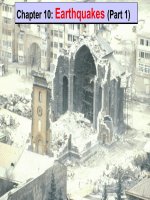Lecture 21 more earthquakes
Bạn đang xem bản rút gọn của tài liệu. Xem và tải ngay bản đầy đủ của tài liệu tại đây (2.41 MB, 28 trang )
Chapter 10: Earthquakes (Part 2)
Announcements
- Papago Park Fieldtrip
Sign up at website.
See maps and directions.
- Quiz postponed until Monday
Volcanoes (Chap. 9)
Earthquakes (Chap. 10)
Earth’s Interior (Inter. C)
- Midterm 2
Rescheduled for a week from
Friday, April 11.
Review outline will be posted on
the web this coming Monday.
-
Most earthquakes occur along
the margins of tectonic plates
Fig. 10.22
W. W. Norton
Today’s Lecture
- Student presentation
“Taiwan Earthquake- 9-21-99”Vilasinee Kongsomboonvech
- Introduction to earthquakes
Where do Earthquakes occur?
Plate tectonic context
- Types of earthquake waves
Body waves
Surface waves
(Video simulations)
Earthquake “belts”
95% of energy from earthquakes comes from thin
zones marking the edges of tectonic plates
Major Earthquake “belts”
Some earthquakes are quite deep (up to 700 km or more)
Deep quakes are found at subduction zones and are
confined to downgoing slabs of lithosphere.
Active Volcanoes
Gaps in earthquake activity define
areas where stress is accumulating.
Fig. 10.36c
W. W. Norton
Seismic gaps:
Mark likely places for future large earthquakes!
n)
Fig. 10.04
EXTENSIONAL STRESS
W. W. Norton
shear)
Earthquakes & Plate Tectonics
Normal Faults (Extensional Stress)
-At divergent plate boundaries, plates move away from each
other at constant rates.
-Examples:
* Red Sea
* Mid-Atlantic
Ridge.
- See video
for opening of
the Red Sea.
n)
Fig. 10.04
COMPRESSIONAL STRESS
W. W. Norton
shear)
Earthquake “belts” & faulting styles
At convergent plate boundaries, oceannic
plates come together forming subduction
zones. Example: Peru-Chile Trench.
Deep Earthquakes in Subduction Zones
Earthquake “belts” & faulting styles
Where converging plates are both
made of continental crust, they collide, forming
mountain belts. Example: Himalayan Mts.
n)
Fig. 10.04
Lateral (Shear) Stress
W. W. Norton
shear)
Earthquakes & Plate Tectonics
Transform Faults (Lateral Shear Stress)
-At transform boundaries, plates slip pass each
other at constant rates.
-Example: San
Andreas Fault
-At the present
rate (~ 1 cm/yr)
San Francisco
and LA will be
neighbors in
~10 million yrs!
Fig. 10.00
U.S. Geological Survey
Summarizing…
Fig. 10.24
W. W. Norton
Major Tectonic Environments of Earthquakes
EARTHQUAKES GENERATE
TWO TYPES OF INTERNAL
OR “BODY” WAVES
P-waves
- Travel faster.
- Move through both solids and liquids.
S-waves: Shear waves
- Travel slower.
- Only travel through solids.
Information carried by these waves is used to:
-Locate the focus of the earthquake.
-Calculate the earthquake magnitude.
- “See” into the Earth’s interior.
P-waves:
- Compression
waves.
Fig. 10.13ab
- Travel fastest.
- Move through
both solids
and liquids.
W. W. Norton
S-waves:
-Shear waves.
-Travel slower.
- Only travel
through
solids.
W. W. Norton
Types of Earthquake Waves
“Body waves”
travel in the Earth’s interior
P-waves (“P” for primary)
Expansion/compression:
push/pull motion
S-waves (“S” for secondary)
Shear:
side-to-side motion
“Surface Waves” travel at the Earth’s surface
Surface Waves
- Cause the
most damage.
- Two types.
* Rayleigh waves:
Forward,
rolling motion.
* Love waves:
Side-to-side
(lateral) motion
- Both are shear
waves.
Love Waves
Fig. 10.13ef
W. W. Norton
In summary: Types of seismic waves
Motion produced by the
different wave types
P-wave
S-wave
Surface-wave









